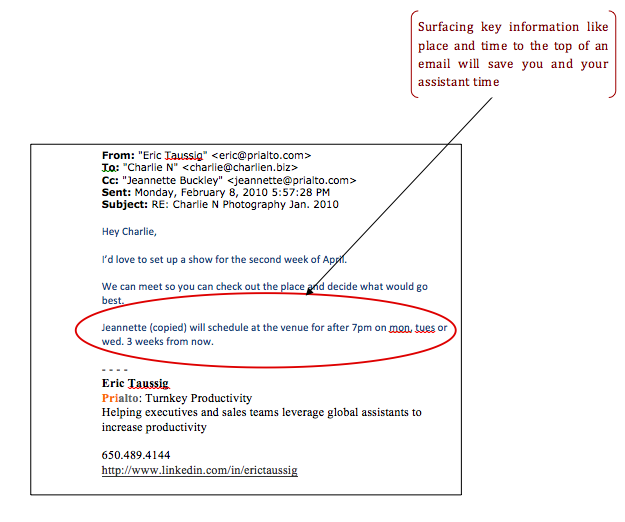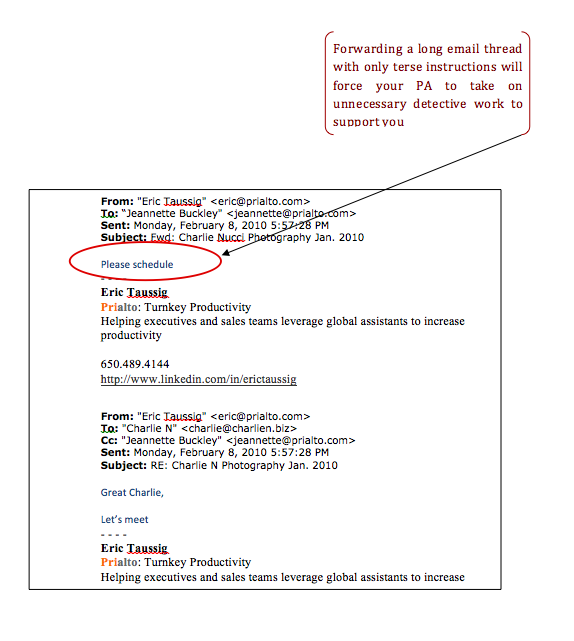Scheduling with Success
Having a human scheduling appointments on your behalf sets you apart from the crowd more than ever in a world of web-published calendars and do-it-all mobile devices
Technology-powered tools now available for scheduling are amazing:
- Web apps like 10to8 and Calendly provide slick functionality for publishing your calendar to the world of people who’d like to select a time to meet with you
- Apple’s Siri takes key scheduling steps on your voice command without you even having to click or swipe
But simply saying “I’ll have my smart phone call your smart phone,” has some key limitations.
Relying entirely on these tools naively implies a business environment in which all parties have an equal interest in meeting. Your most important contacts will appreciate a more personal touch, and human input is critical to navigating the art in that the back-and-forth of “scheduling Ping-Pong”.
So how do you empower your remote admin in the complex and subtle game of business etiquette that starts when two busy people decide to meet and then need to lock down place and time?
It’s not “just” scheduling
Prospective Quickskill members will sometimes say they “only” need help with scheduling, as if to imply this is a simple, commodity task.
They are right when the playing field is even and the parties looking to meet have plenty of time. Then it really is simply a matter of finding the next open spot on the calendar. The algorithm is indeed simple, and technology alone may get it done.
Those experienced in leveraging a professional scheduler will often understand how much time gets consumed in the scheduling ping-pong. They also know that there is an art to navigating through the complexity of how to time reminders and to deciding where and when to meet.
Three tactics for getting it right
So how does one best leverage their assistant to track down targets and get you the right meetings in the right place and at the right time?
1) Start slow in the beginning to go fast later:
Many tech equipped, near autonomous knowledge workers have forgotten this basic management need, but there is always a trade-off between the ease of getting something done yourself today verses taking the time to enable someone else to take it off your hands later. One should never offload key tasks to a new employee without great care. True, you might as well do a task yourself if you will always have to micro mange and explain it to your helper with painful specificity. But micro managing your new scheduler in the beginning is totally appropriate. Take the time to:
- Explain the etiquette of your business and client base
- Download the places you like to meet for which kinds of meetings
- Download the names of your VIPs, the key clients and/or personal contacts that get the highest priority
- Sensitize your assistant on how to discern in your email exchanges the importance of a contact and how that should translate into how a meeting is scheduled
To do all this, you ought to initially watch every email your assistant sends out and then set times to go over and give feedback on how they can be improved. Doing this for just a few days, will quickly yield great time savings and peace-of-mind.
2) Surface key information to the top of long email threads.
A good assistant may successfully disentangle long and complex email threads to decipher what you want done on an email, even if you simply copy him in with no instruction. But it may require a lot of unnecessary energy and time.
A couple of simple specifics as you CC your assistant will save lots of time and energy.
Here’s an email that works well:

Here is an e-mail that does NOT work well:

Develop a scheduling vernacular with your PA
Maintaining positive client relationships with a PA in the middle requires sensitivity. You can’t meet with everyone all the time. You have to prioritize and, while most everyone understands this need, you want to avoid inadvertently insulting even a lower priority contact.
Use special words that you can place in the kind of email copy above to help your PA prioritize on your behalf.
For example:
- To indicate that you indeed want to meet while tactfully letting your assistant know that this meeting is not the highest priority, say things like “please schedule a coffee” or “please schedule for this month”
- To indicate that a contact, Charlie, is a high priority client who you want to defer to, say something like “please schedule at place and time that works well for Charlie
Oh, and one more thing
See Andy Mowat’s article on how to leverage your assistant to do CRM right. If you are looking to have an assistant help you schedule, you probably are tracking lots of contacts. A CRM and a good CRM process can be amazing tools with which to collaborate with your assistant and track key interactions. But if you’re a relationship person, you probably don’t want to spend too much time meticulously inputting data. Configure your CRM to work with your assistant.

